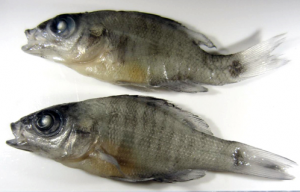

Defending community rights to clean water enforcement
Wednesday, October 18th, 2017 | Posted by Matt Hepler | 1 Comment
Another challenge facing coal: Cleaning up
Tuesday, June 9th, 2015 | Posted by Brian Sewell | No Comments
 From The Appalachian Voice Online: Yet another aspect of the financial perils facing U.S. coal companies is coming into full view. As even some of the nation's largest coal producers run the risk of caving under their debts, regulators and analysts are voicing urgent concerns about cash-strapped companies' ability to pay for reclamation land after mining. [ Read More ]
From The Appalachian Voice Online: Yet another aspect of the financial perils facing U.S. coal companies is coming into full view. As even some of the nation's largest coal producers run the risk of caving under their debts, regulators and analysts are voicing urgent concerns about cash-strapped companies' ability to pay for reclamation land after mining. [ Read More ]Two wrongs don’t make a right: mountaintop removal and stream protection
Wednesday, November 19th, 2014 | Posted by Erin Savage | No Comments
 Two recent studies include more bad news regarding the impacts of mountaintop removal on streams throughout Central Appalachia. One indicates that work done to restore previously degraded streams is inadequate, while the other raises important questions about the feasibility of selenium pollution enforcement. [ Read More ]
Two recent studies include more bad news regarding the impacts of mountaintop removal on streams throughout Central Appalachia. One indicates that work done to restore previously degraded streams is inadequate, while the other raises important questions about the feasibility of selenium pollution enforcement. [ Read More ]Science vs. Mining
Wednesday, July 30th, 2014 | Posted by Eric Chance | No Comments
 Over 2,000 miles of streams have been buried by Mountain Top Removal mining, and many more have been degraded. This seems like it should be illegal, but the destructive practice continues. That's why Appalachian Voices has been working to keep the Environmental Protection Agency (EPA) and industry from opening up new loopholes in our environmental laws that would make it easier to poison streams. [ Read More ]
Over 2,000 miles of streams have been buried by Mountain Top Removal mining, and many more have been degraded. This seems like it should be illegal, but the destructive practice continues. That's why Appalachian Voices has been working to keep the Environmental Protection Agency (EPA) and industry from opening up new loopholes in our environmental laws that would make it easier to poison streams. [ Read More ]Take Action: Protect Appalachian Streams from Toxic Selenium
Wednesday, June 11th, 2014 | Posted by Eric Chance | 15 Comments
 The U.S. Environmental Protection Agency is poised to loosen national recommended water quality standards for selenium, a toxic pollutant commonly released from mountaintop removal coal mines. You can stand up for streams in Appalachia by submitting comments urging the EPA to protect aquatic life and strengthen selenium standards. [ Read More ]
The U.S. Environmental Protection Agency is poised to loosen national recommended water quality standards for selenium, a toxic pollutant commonly released from mountaintop removal coal mines. You can stand up for streams in Appalachia by submitting comments urging the EPA to protect aquatic life and strengthen selenium standards. [ Read More ]Fighting for Clean Water in Virginia: Standing up to Coal Industry Bullies
Tuesday, January 28th, 2014 | Posted by Eric Chance | 2 Comments
 Today, Appalachian Voices along with our allies in Virginia filed a lawsuit against Penn Virginia, for water polluted by selenium coming from abandoned mines on their land. This lawsuit is one in a series of suits aimed at cleaning up selenium pollution in Callahan Creek. [ Read More ]
Today, Appalachian Voices along with our allies in Virginia filed a lawsuit against Penn Virginia, for water polluted by selenium coming from abandoned mines on their land. This lawsuit is one in a series of suits aimed at cleaning up selenium pollution in Callahan Creek. [ Read More ]Appalachian Voices and Partners Challenge Kentucky’s Weakening of Water Pollution Standards for Selenium
Friday, December 13th, 2013 | Posted by Eric Chance | No Comments

This two headed trout was deformed by selenium pollution. Today, we have taken action to keep EPA and Kentucky from allowing pollution like this to get worse.
Earlier today Appalachian Voices and a number of partner organizations sued the EPA over their approval of Kentucky’s new, weaker standard for selenium pollution.
Selenium is extremely toxic to fish, and causes deformities and reproductive failure at extremely low levels. The pollutant is commonly discharged from coal mines and coal ash ponds, but currently Kentucky does not regulate its discharge from these facilities.
These new standards were proposed at the behest of coal industry groups, likely motivated by citizen groups’ success at requiring companies in other states to clean up their selenium pollution. We have also seen the state governments of Virginia and West Virginia take steps towards making similar rollbacks to their own standards, making the EPA’s approval of Kentucky’s weakened standards even more alarming.
(more…)
Effects of Selenium Poisoning: Deformed and Dying Fish at Sutton Lake
Thursday, December 5th, 2013 | Posted by Sarah Kellogg | 4 Comments

Bluegill from Lake Sutton with a deformed spine (top) compared to a normal bluegill (bottom). Photo courtesy SELC
Coal ash, the toxic waste produced by coal-fired power plants continues to plague communities across the country. A new study, conducted by Dr. Dennis Lemly, research associate professor of Biology at Wake Forest University and a leading expert on selenium poisoning, found that selenium from coal ash discharges into Sutton Lake near Wilmington, N.C., is killing more than 900,000 fish each year and causing deformities in thousands more. (more…)
Read More ...Saying “No!” to Toxins in Our Water
Wednesday, November 27th, 2013 | Posted by Tom Cormons | 4 Comments
 Appalachian Voices works with citizens throughout the region to expose water pollution from mountaintop removal mining, and we’ve been advocating for strong state standards to control this dangerous pollutant. We are pushing back on the EPA’s decision on Kentucky, and we’re ready to hit the ground to fight for responsible, enforceable standards in other states.
[ Read More ]
Appalachian Voices works with citizens throughout the region to expose water pollution from mountaintop removal mining, and we’ve been advocating for strong state standards to control this dangerous pollutant. We are pushing back on the EPA’s decision on Kentucky, and we’re ready to hit the ground to fight for responsible, enforceable standards in other states.
[ Read More ]EPA Helps Kentucky Roll Back Water Quality Protections
Friday, November 15th, 2013 | Posted by Erin Savage | 3 Comments

Above are blue gills that were collected below the site of TVA’s 2008 Kingston Coal Ash spill. They all have “pop-eye”, a deformity caused by selenium pollution where their eyes bulge out of their heads. These fish had selenium levels of 2.5-6.5ppm, well below Kentucky’s newly accepted standard of 8.6 ppm for fish tissue.
Just today, after several months of delays, the U.S. Environmental Protection Agency announced its decisions on the Kentucky Department of Water’s (DOW) amendments to the Kentucky Water Quality Regulations. Unfortunately, the EPA has approved substantive changes to the selenium freshwater chronic standard that will not adequately protect aquatic life and will be difficult, if not impossible to enforce at mountaintop removal coal mining sites throughout eastern Kentucky.
In theory, states review their water quality standards every three years in an effort to make sure these standards are up-to-date with current science and are protective of aquatic life. In some cases, however, the review becomes an opportunity for special interests to influence state agencies. This year, under pressure from the coal industry, the Kentucky DOW proposed to weaken selenium standards. Standards are used to set permit limits for industries that may discharge pollutants into public waterways. Though some mines in Kentucky are known to discharge selenium into streams, the Kentucky general permit for valley fills does not currently include selenium permit limits.
Selenium is a naturally occurring element that can be released into streams through mountaintop removal coal mining. Once in the water, selenium bioaccumulates in fish and other aquatic life, increasing in concentration up the food chain. Selenium is toxic to aquatic life at very low levels. For these reasons, Appalachian Voices and our allies have been working to challenge Kentucky’s proposed selenium standards.
Kentucky DOW proposed to raise the acute selenium standard from 20 ug/L in the water column to 258 ug/L in the water column. They also proposed changing the chronic standard of 5 ug/L to a more complicated system where a level of 5 ug/L in the water column would not be enforceable, but instead would trigger the need to sample fish tissue. The new chronic standard would be 8.6 ug/g in fish tissue, or 19.2 ug/g in egg/ovary tissue. The 5 ug/L water concentration would only be an enforceable limit if no fish were available for sampling.
(more…)





